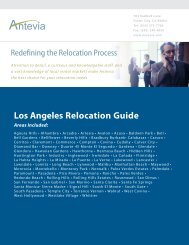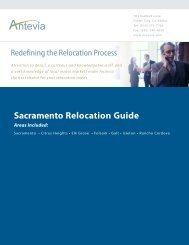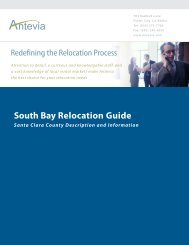San Francisco Relocation Guide - Antevia
San Francisco Relocation Guide - Antevia
San Francisco Relocation Guide - Antevia
Create successful ePaper yourself
Turn your PDF publications into a flip-book with our unique Google optimized e-Paper software.
Fillmore District, <strong>San</strong> <strong>Francisco</strong>,<br />
California<br />
From Wikipedia, the free encyclopedia<br />
The Fillmore District, also called The Fillmore or The Lower Fillmore, is a<br />
neighborhood in <strong>San</strong> <strong>Francisco</strong>, California. Though its boundaries are not well-defined, it<br />
is usually considered to be the subset of the Western Addition neighborhood bordered by<br />
Fillmore Street on the west, Van Ness Avenue on the east, approximately Geary<br />
Boulevard on the north, and approximately Grove Street on the south. Sometimes the<br />
western boundary is extended to Divisadero Street north of Golden Gate Avenue. The<br />
neighborhood is in <strong>San</strong> <strong>Francisco</strong>'s fifth district, and is served by several Muni bus lines<br />
including the 38, 31, 5, and 22.<br />
The Fillmore was the site of a massive and controversial Urban renewal project begun in<br />
the 1950's, the last vestiges of which are still ongoing. It has an ethnically and<br />
economically diverse population, and is the historical center of African-American culture<br />
in <strong>San</strong> <strong>Francisco</strong>. Today, despite the persistence of poverty and violent crime, the<br />
Fillmore is seeing increased residential and commercial development. In particular the<br />
area is reviving as a center of music, with a branch of Oakland-based jazz club Yoshi's<br />
and a jazz history museum expected to open in 2007, joining existing venues such as the<br />
Boom Boom Room, Rassalla's, the Sheba Lounge, and the well-known Fillmore<br />
Auditorium.<br />
History<br />
In the 1800's, the Fillmore was a predominantly Jewish neighborhood, with vegetable<br />
farms surrounding the developed area around Fillmore Street. Many Japanese immigrants<br />
also came to the Fillmore around the turn of the century. After the 1906 earthquake<br />
Fillmore Street, which had largely avoided heavy damage, temporarily became a major<br />
commercial center as the city's downtown rebuilt.<br />
In 1942, during World War II, President Roosevelt signed an executive order to relocate<br />
all people of Japanese origin to internment camps. The vacant homes in the Fillmore<br />
attracted African-American industrial workers, musicians, and artists. Soon many<br />
nighclubs were opened, bringing major musical icons to the neighborhood including Ella<br />
Fitzgerald, Louis Armstrong, and Billie Holiday. The neighborhood struggled<br />
economically, however, and many of its Victorian homes fell into disrepair.







